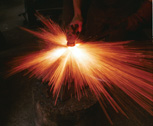
.
Held in our hands iron is an extremely hard and strong material. For us to shape it by hand would be impossible were it not for its characteristic of becoming fully malleable, when heated, within quite a wide range of temperatures below its melting point.
This simple property means that manipulations that would require large and powerful machinery when cold can be effected by hand when hot. Forging can be likened to the forming of clay or plasticine between fingers and thumbs; replacing the fingers and thumbs with tongs, hammer and anvil, the clay or plasticine with yellow hot iron. This iron can, while hot, be stretched and squeezed, bent and twisted, pierced, beaten,split, curled, tapered, thickened and joined – all by the hand that wields the hammer. When cool the finished piece regains its strength and hardness but will also, in its new shape, hold the spark of life that those hands have imparted to it. Every blow being different, no two forged objects can be identical; the very nature of forged work is to be vibrant, alive and individual and it is this that gives the work of the smith a fresh relevance today.
Amid the often soulless and shoddy productions of a quantity obsessed culture the truly handmade artefact, in whatever medium, has a wealth to offer.
As blacksmiths we make use primarily of forging processes and techniques.
In the production of more traditional pieces this is usually to the exclusion of modern techniques such as electric arc welding – as our intention is to provide the genuine article and not a production line facsimile.
In our commissioned work we feel free to make use of all the methods at our disposal as dictated by the requirements of the job in hand. We work mainly in steel and wrought iron. We also use stainless steel, copper, bronze and other materials as appropriate.